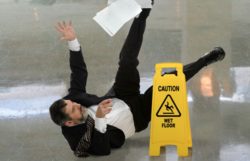
The factors that turn a slip into a fall are minuscule and can change in an instant. When a stumble turns into a fall it can mean that someone ends up in the hospital or has an embarrassing story that is shared later with friends and family. Preventing a stumble from turning into a fall depends as much on luck as it does on preparation. Falls can be deadly for the elderly and people with prior serious injuries. A study is examining the factors that convert a stumble into a fall to better understand how elder care facilities can be designed to mitigate these risks.
Falls Increase Among the Elderly
A recent study conducted by the University of Michigan and published in JAMA Internal Medicine found that falls are increasing among the elderly. The study was conducted over a 12-year period and found an eight percent increase in falls for people over the age of 65 which translates roughly to a 30 percent increase in falls overall. The researchers noted a disturbing trend in which the rate of falls increased faster than the aging population, indicating that factors other than simply a larger number of older adults accounted for the increase in falls. The researchers posit that as the American population continues to age, injuries and fatalities related to falls are likely to increase.
According to a government study, about one in three older adults fall each year. Among those who fall about 2.2 million need medical attention and one in ten suffer a serious injury. The deadliest injuries are broken hips which are often first in a deadly spiral that eventually leads to death. About 340,000 people suffer broken hips a year due to falls. About a quarter of them will die within a year, half who make it through physical therapy will never walk unaided again, and 40 percent will need a nursing home for the rest of their lives.
Slip (stumble) vs. Fall
A slip is a momentary loss of balance; it can be caused by a variety of factors including:
- Debris on the pathway;
- Imperfection on the ground; and
- Slippery substances on the floor or shoe.
A slip is relatively harmless. The person temporarily loses balance, but a combination of luck and quick reflexes ensures the person reorients and avoids the fall. Conversely, falls occur when people are unable to reorient themselves. They can fall forward, backward, or onto their side. Usually (due to instinct) people will reach out with a hand in an attempt to break their fall which often results in sprained or broken wrists, fingers, and hands.
Factors that turn slip into a fall
In response to these findings, the University of Virginia Tech began studying the nature of falls, the factors that contribute to them, and possible solutions to alleviate their risk. The study is reviewing a series of elderly test subjects. The subjects are strapped into harnesses that protect them from falling. They are then asked to walk through a particular course filled with debris, slippery substances, uneven floors and other factors that contribute to slips and falls. The subjects are outfitted with sensors to measure muscle response, gait, and the force of each step to assess every factor that is involved in the fall-event.
The researchers noted the following factors contribute to falls:
- Drops in blood pressure due to standing too suddenly;
- Impaired vision;
- Weakened muscles (which reduces balance);
- Dementia;
- Using four or more prescriptions; and
- Arthritis.
Injuries Suffered in a Fall
The injuries suffered in a fall can range from being relatively benign, such as bumps, bruises, contusions, cuts, and bruised egos, to severe including concussions, injured backs, shoulder sprains, broken wrists, and broken hips. Broken hips by far account for the largest share of fatalities related to falls. Broken hips are notoriously difficult to recover from and are often trigger injuries that lead to death.
Solutions
The researchers recommend that older adults:
- Keep their glasses prescriptions up to date;
- Remove throw rugs;
- Keep pathways clear; and
- Do not use too much furniture with legs.
For nursing homes, the researchers emphasize that doctors who administer balance tests for any resident over the age of 75. If the resident fails the balance test, they should not be permitted to move about unassisted. Unfortunately, falls do not receive the same scrutiny as other issues in nursing homes. Therefore, most of these guidelines are routinely ignored by doctors.
Another persistent problem is that fall victims frequently do not come forward which exacerbates their injuries. Fall victims often refuse to admit that they suffered a fall or need assistance because of embarrassment. Researchers recommend that family members carefully monitor their loved ones for signs of imbalance and ensure that they have the walking assistance-devices they need.

